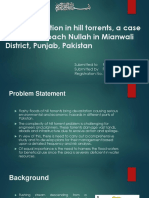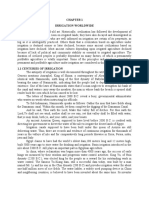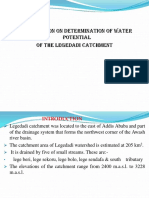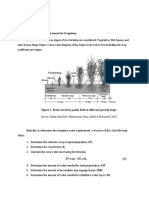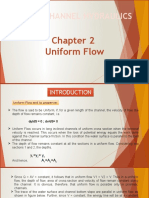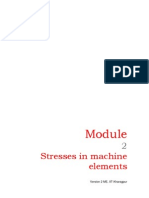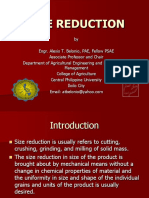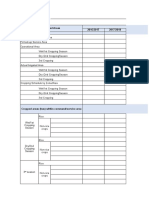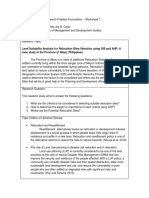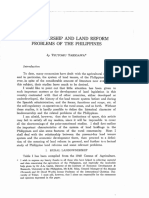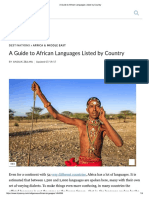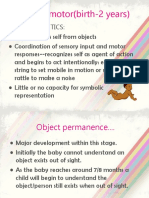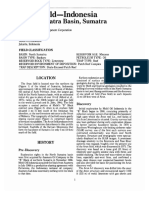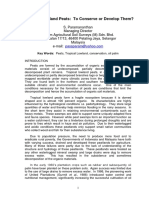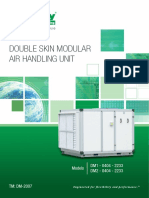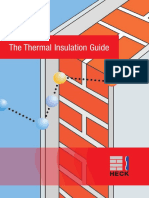Bosigon IP-Conduct of FS (TOR)
Bosigon IP-Conduct of FS (TOR)
Uploaded by
Rhea CelzoCopyright:
Available Formats
Bosigon IP-Conduct of FS (TOR)
Bosigon IP-Conduct of FS (TOR)
Uploaded by
Rhea CelzoOriginal Description:
Original Title
Copyright
Available Formats
Share this document
Did you find this document useful?
Is this content inappropriate?
Copyright:
Available Formats
Bosigon IP-Conduct of FS (TOR)
Bosigon IP-Conduct of FS (TOR)
Uploaded by
Rhea CelzoCopyright:
Available Formats
Republika ng Pilipinas
National Irrigation Administration
(Pambansang Pangasiwaan ng Patubig)
Lungsod ng Naga
Office Address: National Irrigation Administration, Region 5
Panganiban Drive, Naga City Telefax No. (02)473-8967
Telephone Nos.: (054) 473-8967/472-2121 TIN No. 000-916-415
Website: www.nia.gov.ph
Terms of Reference (TOR)
for the
Conduct of Feasibility Study (FS) for the
BOSIGON IRRIGATION PROJECT
I. BACKGROUND/RATIONALE
1.1 Contracting Authority
The General Appropriation Act (GAA) of 2018 has allocated the amount of Fifteen Million
Four Hundred Pesos (Php 15,400,000.00) for the conduct of feasibility studies (FS) to be
administered by the National Irrigation Administration (NIA)-Region V.
NIA-Region V shall be the Implementing Agency and Contracting Party. The proposed
project is consistent with NIA’s major programs/projects/activities (PPAs).
1.2 Relevant Country/Sector Context
The project is supportive of the thrusts of the 2017-2022 Philippine Development Plan
(PDP) under Chapter 8 (“Expanding Economic Opportunities in Agriculture, Forestry, and
Fisheries”), particularly the Government’s goal on improving food security and increasing
rural income by enhancing farm productivity. Moreover, the project’s focus on rice
production is also expected to complement the Food Staples Self-Sufficiency Program
(FSSP) of the Department of Agriculture (DA).
The project is also in line with the sector outcomes under Chapter 10 of the PDP
(“Accelerating Infrastructure Development”) by enhancing the performance of the
irrigation sector and enabling development in the energy sector.
1.3 Current State of the Irrigation
Agriculture is one of the major sectors of the economy, which provides job to the labor
force and contributes to the Gross Domestic Product (GDP). One of the primary objectives
of the Government is to increase the self-sufficiency rate in rice. Attaining a higher self-
sufficiency rate means increasing rice production. Therefore, the generation of new
irrigated areas will help increase rice production, which, in turn, will increase self-
sufficiency rate in rice.
2. OBJECTIVE AND EXPECTED OUTPUTS
2.1 Overall Objective of the Study
The objective of the proposal under this TOR is to conduct the FS of the BOSIGON IP. The
FS is a new undertaking. It shall cover the technical, economic and financial aspects of the
proposed irrigation and multipurpose project, including environmental study,
vulnerability assessment, preparation of sustainable plans, and analysis of alternative
financing schemes, among others.
TOR: Feasibility Study for the proposed BOSIGON IP 1 of 39 | P a g e
Additionally, the FS shall ensure that the value engineering/value analysis (VE/VA) 1 is
undertaken with regard to the selection of the best possible implementation/project
options/configurations/technology for the project (may include new available
technology which can be used to deliver the project component/s of the project), to
ensure that the best scheme for providing the project’s intended output will be selected,
which would yield the highest value-for-money (VfM), as articulated in the Scope of
Works under Section 3 below.
It is noted that the development/construction of the hydropower component of the
project may be suitable for Public-Private Partnership (PPP). If found viable under this
TOR for private sector participation, the feasibility of undertaking a specific PPP modality
to implement the hydropower component, including the preparation of the PPP
transaction, shall be undertaken under a separate study, given that the FS Fund
administered by NIA only covers non-PPP projects. However, the technical, environmental,
social, market, demand, and other aspects of the hydropower component shall already form
part of this TOR, e.g., a business case study.
2.2 Expected Output of the Study
By the end of the contract period under this TOR, the Consulting Firm is expected to
produce a complete and acceptable FS based on updated information, with a definite
implementation plan of the recommended scheme based on the
alternatives/configurations/technologies considered, among others, including the
preliminary engineering designs and the most appropriate financing scheme.
3. SCOPE OF THE WORK
3.1 General Scope of Works
The scope of work of the Consulting Firm under this TOR shall include, but not necessarily
be limited to, the following:
3.1.1 Undertake assessment of existing situation in the basin including the following,
among others:
a. Assessment of the socio-economic conditions, and performance of the
agriculture sector in the concerned municipality of Labo, Camarines Sur over
the past 10 years with focus on the past five (5) years. Include in the
assessment: sources of income and employment, production patterns and
trends, access to markets, crop production and demand, and equity.
b. Identification of problems, and known causes and effects on agriculture
performance, strengths, weaknesses, opportunities and threats to the
development of the municipality. Causes of problems may include, among
others, policy issues (e.g., incentive structures), institutional (e.g. structures
and capacity), health and governance issues, and investment issues (e.g. low or
poor quality) that affect agriculture production and productivity. Identify key
performance indicators and trends such as incomes, productivity, and other
social indicators.
1For reference, the Value Analysis Handbook for NEDA (2009) may be downloaded from:
http://www.neda.gov.ph/wp-content/uploads/2014/01/Value-Analysis-Handbook.pdf
TOR: Feasibility Study for the proposed BOSIGON IP 2 of 39 | P a g e
3.1.2 Undertake necessary feasibility level studies, institutional analysis,
environmental and social assessment (ESA), resettlement considerations, design
and monitoring framework, VE/VA study, vulnerability assessment,
identification and assessment of borrow/quarry areas, and necessary
preliminary engineering designs, in conjunction with beneficiaries and other
stakeholders to establish the viability of investment in the following aspects:
economic, financial, technical, etc.
The ESA, consistent with the requirement of the proponent, should be
substantiated in the FS to cover the environmental and social setting of the
proposed project which includes affected people including Indigenous People.
In terms of resettlement, a Land Acquisition Resettlement Framework (LARF)
shall be formulated in preparation of the detailed resettlement plan. On the IP
concern, the consultant should clearly identify the profile of the IP community
delineating their territorial and documenting their customary rights and
decision-making process for the preparation of an Indigenous People
Development Plan (IPDP). For the watershed, include characterization to
established baseline condition of the watershed (flora, fauna, land use, etc.) and
identify existing management plans and programs to ensure sustainability of
irrigation water supply and identify involvement of the proponent in the
watershed management.
The FS shall look at alternative options, including the associated costs, benefits
and risks involved, in delivering the project or components of the project (may
include new available technology which can be used to deliver the project or
component/s of the project), and selecting the best possible
implementation/project options/configurations/technology involved, for the:
(i) entire irrigation and hydropower system (for example, either high dam,
series of cascading small dams, combination of high dam and small cascading
dams, high dam with penstock for implementation of the hydropower generation
component at a later date as a separate project, or small water impounding
reservoirs within the service area, among others), either as an integrated system,
or considering the irrigation system separately ( in case the hydropower
component is not found feasible); and (ii) individual components of the
irrigation system or of the integrated irrigation and multipurpose system. This
would ensure that the best scheme for providing the project’s intended outputs
will be selected, which would yield the highest VfM, e.g. lowest lifecycle/whole-
of-life costs, taking into account all alternative ways of delivering the desired
outputs and enhancing the primary outputs by considering other incidental
benefits (e.g. provision of water supply source and flood management in the
overall scheme). The Consulting Firm shall select the best alternative and/or
project components that would most appropriately respond to the project
objectives and output, and yield the highest VfM, such as in terms of lowest
cycle/whole-of-life costs.
The VE/VA study shall also include and indicative analysis of alternative
financing schemes, e.g., whether full National Government (NG) funding, Official
Development Assistance (ODA), or PPP, including an analysis of financing risk.
The analysis of alternative financing schemes shall consider various
implementation options, e.g., irrigation component implemented separately
from the hydropower component (if hydropower is not found viable to
implement), integrated irrigation and power generation component (if
TOR: Feasibility Study for the proposed BOSIGON IP 3 of 39 | P a g e
feasible), irrigation component with penstock implemented first and
hydropower component to be implemented as a separate project, etc.
3.1.3 Prepare feasibility level outputs documenting the viability of the project works,
including the hydropower component with cost of transmission and
distribution lines including right-of-way (ROW), while adequately addressing
hazards and risks, environmental issues, and resettlement issues, outlining in
detail the implementation arrangements. The technical, environmental,
institutional, social, market, demand, and other aspects of the hydro
component (e.g., business case study) shall also be included.
Further, the existing institutional arrangements regarding the development,
construction, operation, and management of the hydro component shall be
investigated by the Consulting Firm, including the institutional linkages
between NIA and other relevant agencies on development and implementation
of the hydropower component.
3.1.4. During the contract period, conduct of coordination meeting with NIA, Local
Government Units (LGUs), Irrigators Associations (IAs) and other stakeholders
to: (a) discuss the progress of the work and preliminary output; (b) give the
Government the opportunity to make comments and suggestions on a timely
basis; and (c) resolve problems and issues that may be encountered. The
Government may assign counterpart personnel to the study for purposes of
transfer of technology and capacity building. The Consultant shall provide for
the required office space for the Government counterparts.
3.2 Key Experts and Activities
Following are the key experts required and the corresponding major activities, which
they will undertake, among others:
3.2.1 Water Resources Development Planning Specialist/Team Leader
a. Provide overall direction to all specialists making up the consulting team;
b. Manage relationships with concerned departments/units of NIA at the central,
regional and field office, LGUs, IAs and with other stakeholders including
farmers, non-government organizations, and project-affected families;
c. Prepare detailed, time-bound work plans for the preparation of the VE/VA
study and detailed FS, assigning various team members to each key task;
d. Provide technical support and guidance in all aspects of the consultancy
services;
e. Organize and take the lead in the conduct of regular site visits to the dam site
and irrigation service areas for the technical supervision in undertaking the
required survey and mapping and the carrying-out of geological and
geotechnical confirmatory tests;
f. Monitor the progress of all planning and design work, ensuring that deadlines
relating to delivery dates are met;
TOR: Feasibility Study for the proposed BOSIGON IP 4 of 39 | P a g e
g. Take the lead and assign/delegate other tasks/activities to the members of the
Consultancy Team and support staff as may be required during the conduct of
the Study, including, but not limited to: (1) undertaking of the VE/VA study and
vulnerability assessment for the proposed project; and (2) review and
investigation of the existing institutional arrangements for the hydropower
component, among others;
h. Ensure the timely delivery and quality control of all required outputs, in
particular, the Inception Report, VE/VA Report, Monthly Progress Report,
Interim Report, Draft FS Report, and Final FS Report; and;
i. Ensure that NIA is furnished the prints and electronic copy of the
abovementioned deliverable reports; these shall include all necessary tables
and figures to facilitate and expedite complete review of the submissions.
3.2.2 Planning Engineer/Dam Engineer/Deputy Team Leader
a. Provide assistance to the Team Leader in the overall supervision of the various
assessment study activities;
b. In the absence of the Team Leader, assume full responsibility, including
leadership of the Consulting team;
c. Undertake the review/updating of design and cost parameters considered in
previous studies, in coordination with the other key experts;
d. In collaboration with other experts/specialists, select the most appropriate
scheme for the objective (e.g., type of dam to be adopted if the recommended
solution to the objective is construction of high dam), based on comparison of
alternative schemes of development. Recommend the definitive viable,
acceptable, and doable plan for implementation;
e. Check and review prepared topographic map of the reservoir area and dam
site. Locate and layout the propose dam axis and appurtenant structures;
f. Conduct site inspection/field investigation to determine the extent of
topographic work and mapping necessary for feasibility design. Classify the
type of terrain, meandering of the river, and water ways;
g. Given the data from borehole tests and after identifying probable location of
faults, evaluate the proposed dam axis and alignments of appurtenant
structures;
h. Using data gathered from the Hydrologist, perform hydraulic analysis for
discharge (e.g., flood routing, afflux analysis) depending on the scheme to be
implemented. This also involves sizing of diversion conduit, spillway, sluice
gate/s, ogee weir, and other related structures;
i. Prepare cost comparison for the different schemes under consideration and
use this as input in the determination of the appropriate project development;
j. Provide risk assessment that would determine whether the dam option is a
referable dam, if there is a danger of the dam failing (dam-break analysis), and
which action is necessary to prevent or minimize the impact of the failure.
TOR: Feasibility Study for the proposed BOSIGON IP 5 of 39 | P a g e
Perform seepage analysis for filter drain sizing and slope stability analysis
involving different conditions;
k. Prepare necessary data needed by the electro-mechanical experts for carrying
out feasibility design of mechanical and electrical works;
l. Prepare necessary data needed by the Economist to carry out an economic and
financial analysis, which may include options for hydropower development;
m. Prepare the feasibility grade drawings and plans of dam, and appurtenant
structures/facilities. Provide electronic copies of plans, layouts, and other
drawings. Submit/provide hydraulic/design computations;
n. Review the hydraulics and structural aspects for the power components;
o. Take the lead in preparing the drafts of the Inception Report, VE/VA Report,
Monthly Progress Reports, Interim Report, Draft FS Report, and Final FS
Report; and
p. Undertake other tasks/activities assigned/delegated by the Team Leader as
may be required during the conduct of the Study, such as that articulated in
Item (g) of Section 3.2.1 of this TOR.
q. Conduct preliminary site investigations in relation to the hydropower
component, including hydrologic, topographic, geologic, and geotechnical
studies;
r. Review sedimentation study carried out by the Hydrologist to identify the
least-cost solution with minimum environmental impacts; and prepare any
disaster risk management plan including a flood control and early warning
system with the Hydrologist;
s. Design the required hydraulic turbine/pump, penstock, gate valves,
generator, and their control;
t. Identify the location of the turbine/pump, transmission lines, powerhouse,
and other components;
u. Select the main hydropower characteristics such as installed capacity, energy
production, capacity factor, and so forth to produce the appropriate power
generation scheme for the project;
v. Develop preliminary layouts of hydraulic structures, electro-mechanical, and
electrical equipment;
w. Develop preliminary cost estimates based on major quantities and cost items
(e.g., turbine/pump, powerhouse, penstock, generator, gate vales,
transmission lines, and distribution lines including ROW);
x. Identify potential social and environmental impacts, and proposed solutions;
y. Highlight the main risks facing the project hydropower component, and
possible mitigation measures;
TOR: Feasibility Study for the proposed BOSIGON IP 6 of 39 | P a g e
z. Prepare the necessary data needed by the Economist and the other experts to
carry out indicative assessments of the hydropower component from various
aspects (e.g., economic viability, financial viability, technical viability,
environmental and social viability); and
aa. Undertake other tasks/activities assigned/delegated by the Team Leader as
may be required during the conduct of the Study, including inputs to the
conduct of VE/VA, etc., and as needed by the other experts, as articulated in
Item (g) of Section 3.2.1 of this TOR
Note: The specific details concerning the appropriate scheme, applied methodology for
the assessment, etc. of the item D shall form part of the consultant’s Work Plan, Inception
Report, VE/VA Report, among others which shall be subject to consultation with and
approval of NIA. Field validation of NIA concerning the above listed must be facilitated by
the consultant, as the need arises.
3.2.3 Soil and Land Classification Specialist
a. Undertake the review/updating of soil and land classification data/analysis
considered in previous studies;
b. Collect, update, review, and validate any soil and land classification report,
publications, and other references such as FS reports related to the project
concerned;
c. Collate and study the existing available soil and land resources data;
d. Perform slope quantification for the determination and delineation of the
various slope class based on topographic maps;
e. Perform semi-detailed soil and land classification survey using topographic
maps and satellite imaginary printouts, and determine possible locations of
boreholes and master pits in the potential service area;
f. Conduct soil profiling and collect soil samples for subjecting to physical and
chemical analysis in order to facilitate the fertilizer recommendation for the
different crops to be grown in the area;
g. Carry out land use mapping, soil characterization, and land class correlation
based on the inherent and morphological characteristics of the soil such as
physical and chemical properties, topography, drainage and parent materials,
and design into appropriate mapping units for the report;
h. Provide the reviewer an electronic copy of the generated maps/layouts for
confirmation and validation to the extent of the service area;
i. Provide the reviewer the authenticated copy of the soil laboratory analysis
(physical and chemical) for validation to facilitate the review, and;
h. Undertake other tasks/activities assigns/delegated by the Team Leader as may
be required during the conduct of the Study, such as that articulated in Item (g)
of Section 3.2.1 of this TOR.
TOR: Feasibility Study for the proposed BOSIGON IP 7 of 39 | P a g e
3.2.4 Agriculturist
a. Undertake the review/updating of agronomic analysis considered in previous
studies, if any;
b. Identify the major constraints faced by the farming communities in the service
area, which affect agricultural productivity;
c. Conduct farm management survey through interview of farmers in all the
municipalities/barangay covered by the proposed project. The interview
should cover at least 10% of the total number of farming households in the
proposed service area;
d. List down all the possible farmer beneficiaries in the proposed service area and
determine their family size, farm holding status, farm size, individual land use,
and the cropping condition (irrigated or rain fed);
e. Request barangay officials’ data such as demographic profile, inventory of farm
machines and post-harvest facilities, number of farm animals (especially draft
animals used in farming), and farmers’ cooperatives;
f. Collect secondary agricultural data to support the agronomic analysis (e.g.,
data that can be collected will include the updated agricultural profile and
comprehensive land use plan of the municipalities covered by the proposed
project, among others);
g. In the case that an existing irrigation system is present and will be covered by
the project, collect the necessary data needed such as the latest O&M report,
which may include data on the firmed-up service area (FUSA), actual irrigated
area during the wet and dry seasons, and production performance (average
yield);
h. Collaborate with the Soil Specialist to determine the extent of area planted to
specific crop and the classification of soil in the area to identify possible crops
to be planted in the future with project condition;
i. Collaborate with the Hydrologist to determine the appropriate crops that can
be planted to the area, and ultimately develop a future cropping pattern;
j. Provide the reviewer an electronic copy of the survey returns for validation to
facilitate the review; and
k. Undertake other tasks/activities assigned/delegated by the Team Leader as
may be required during the conduct of the Study, as articulated in Item (g) of
Section 3.2.1 of this TOR.
3.2.5 Hydrologist
a. Undertake the review/updating of hydrologic parameters considered in
previous studies;
b. Collect/update and validate hydro-meteorological data within the
basin/hydrological region with the last year available record preferably not
older than one (1) year;
TOR: Feasibility Study for the proposed BOSIGON IP 8 of 39 | P a g e
c. Perform actual discharge measurement of water source for low and high
flows, if possible, at the identified/proposed dams and perform flow duration
curves. In the use of stochastic or deterministic method of runoff estimation,
calibrate the derived runoff with the base runoff of the base station. Present
and discuss the conceptual models used; however, preference is given to the
data gathered thru the conduct of actual discharge measurement on the river
source to establish a reference base flow;
d. Estimate the water requirement using a ten (10) day rainfall derived from
daily rainfall at various cropping calendar to determine the least water
requirement. Include the climate change scenario for ready reference;
e. In case there are several water users/water permit grantees or irrigation
systems drawing water from the same source, perform systems/basin water
balance;
f. Perform hydrologic generation is included, if necessary. In case of reservoir
type of dam, perform the detailed reservoir operation studies using the
decadal simulation at multiple water levels using single crops or multi-crops
(diversified crops as recommended by the Agronomist) as an input for wider
range of economic evaluation, financial evaluation, VE/VA (include discussion
of all phases that been carried analysis for various schemes/alternatives sites,
taking into account also case where hydropower out such as information
function analysis, creative evaluation, development and presentation phase),
etc.;
g. Estimate proposed irrigable areas per dam site based on
available/dependable water supply;
h. Gather water samples on several flood ways, proposed dam sites, and
groundwater wells for water quality testing and mapping of polluted water-
intruded areas;
i. Carry-out sediment transport analysis for several flood ways and each dam
site for the determination of sediment-discharge relationship and adjustment
of sediment rate suited to current conditions of the watershed.
j. Conduct flood studies for different return periods. In estimating the unit
hydrograph, preference is given to the use of actual peak discharge data from
different flood events in the water source or nearby rivers, rather than the
empirical SCS dimensionless unit hydrograph method. In the event that SCS
method is employed, comparison to other methods is required;
k. Compute the design flood hydrographs for the following return periods: 2, 5,
10, 15, 20, 25, 50, 100, 200, 500, 1000, and 10,000, if possible, include also
the Probable Maximum Flood (PMF); and
l. Undertake other tasks/activities assigned/delegated by the Team Leader as
may be required during the conduct of the Study, such as that articulated in
Item (g) of Section 3.2.1 of this TOR.
TOR: Feasibility Study for the proposed BOSIGON IP 9 of 39 | P a g e
3.2.6 Cost Engineer / Quantity Surveyor
a. Undertake the review/updating of cost estimates considered in previous
studies, including cost estimates for the hydropower component, if any;
b. Gather unit costs of construction materials or construction costs in the project
area;
c. Prepare unit price analysis of various construction pay items of works specific
to the project area;
d. Prepare the quantity and cost estimate of civil works and other components of
the project during the master planning and feasibility stage; and
e. Undertake other tasks/activities assigned/delegated by the Team Leader as
may be required during the conduct of the Study, as articulated in Item (g) of
Section 3.2.1 of this TOR.
Note: The detailed Cost Estimates for the Project are needed to ensure
minimum variation with the Detailed Engineering cost estimates. Other
projections including cost escalation if a delay of 2, 3, or 4 years occurs
before project implementation must also be presented.
3.2.7 Geologist
a. Review relevant geologic reports from other agencies (e.g. MGB,
PHIVOLCS, etc.) and update geologic parameters considered in the
old studies, if any;
b. Conduct Engineering Geological and Geohazard Assessment
(EGGA) with mapping to determine the existing lithology and the
engineering characteristics of the soils, rock materials and rock
masses in the place, supply design data, and identify potential geo-
hazards that may affect the Project.
• Conduct deterministic and probabilistic seismic analysis on
critical areas, such as the proposed dam site, main canals,
power house, etc., and recommend seismic loading for design.
Should also identify the Maximum Design Earthquake (MDE),
Maximum Credible Earthquake (MCE), and Operational Basis
Earthquake (OBE);
• Assess susceptibility of project components to other seismic
(shaking, rupture, liquefaction) and non-seismic (landslide and
fluvial) hazards;
• Conduct slope stability assessment of the abutments applying
rock mass characterization/rating systems, using any of the
TOR: Feasibility Study for the proposed BOSIGON IP 10 of 39 | P a g e
following systems: Geologic Strength Index (GSI), Slope Rock
Mass Rating (SMR), Rock Mass Rating (RMR), and Slope
Stability Probability Classification (SSPC), and kinematic
analysis
c. Conduct sub-surface geological investigation, including exploration
for construction materials, by core drilling and the necessary field
test and test pitting, as stipulated in Annex A and provide literature-
substantiated interpretation of data, which includes:
i. Standard Penetration Test (SPT) and computation of
allowable bearing capacity;
ii. Water pressure testing;
iii. Laboratory testing to determine the engineering
properties of the drill cores and embankment materials
samples.
d. Provide recommendations on the safety and stability of the
foundation including optimal slope angle of future cut-slopes, etc.,
based on determined engineering properties of the rock masses and
identified geo-hazards.
e. Ensure the production of the following maps:
i. Engineering geological map of dam site at any readable
scale;
ii. Engineering geological map of reservoir area
iii. Geological cross-sections of the dam, spillway, and conduit
axes showing lithology and lithologic contacts,
discontinuities and assumed level of firm foundation (limit
of excavation)
iv. Location of potential borrow areas for construction
materials, including approximate volume of available clay,
random fill materials, and aggregates
f. Undertake other tasks/activities assigned/delegated by the Team
Leader as may be required during the conduct of the Study, as
articulated in Item (g) of Section 3.2.1 of this TOR.
Note:
• The consultant should notify NIA geologist if drilling has already
commenced for them to conduct field visit to observe on-going
drilling activities. This is to facilitate efficient review of the
factual/geologic report.
TOR: Feasibility Study for the proposed BOSIGON IP 11 of 39 | P a g e
3.2.8 Electro-Mechanical Engineer
a. Undertake the review/updating of design and cost parameters of Electro-
Mechanical works considered in previous studies, in coordination with other
key experts, if any;
b. Prepare the design, specifications, and cost estimates of the electrical and
mechanical portion of the dam and other alternatives being considered, and
their appurtenant structures; and
c. Undertake other tasks/activities assigned/delegated by the Team Leader as
may be required during the conduct of the Study, as articulated in Item (g) of
Section 3.2.1 of this TOR.
3.2.9 Economist
a. Undertake the review/updating of financial and socio-economic parameters
considered in previous studies;
b. Gather agro-economic data within the project area and supporting
agricultural data from concerned Government agencies and private entities;
c. Use input from various specialist on the team to develop detailed feasibility
level cost and benefit estimates;
d. Identify the various financing alternatives as well as corresponding risks for
the identified options being considered during the conduct of the VE/VA
study. Further, preliminary economic and financial analyses for the identified
alternatives shall be undertaken, including the schemes/options with
hydropower generation. These shall also serve as input in coming up with
final recommendations to respond to the objectives of the project;
e. Based on the results of the VE/VA study, undertake detailed economic and
financial analyses for the selected option/alternative;
f. Present the derivation of the following: (in the “without” and “with” project
conditions), including a case with hydropower generation:
i. Price structure;
ii. Physical inputs;
iii. Cost of production;
iv. Economic cost of farm labor;
v. Net value of production;
vi. Economic analysis of net value of production;
vii. Crop budgets;
viii. Farm budgets;
ix. Project cost (investment, O & M, replacement, etc.);
x. Benefits (irrigation, power, fishery, etc.);
xi. Financial internal rate of return (IRR), economic IRR, economic net
present value (NPV), Financial NPV, and economic and financial
benefit/cost (B/C) ratio; and
xii. Sensitivity analysis; and
TOR: Feasibility Study for the proposed BOSIGON IP 12 of 39 | P a g e
g. Undertake other tasks/activities assigned/delegated by the Team Leader as
may be required during the conduct of the Study, such as that articulated in
Item (g) of Section 3.2.1 of this TOR.
3.2.10 Survey and Mapping/Geodetic Engineer
a. Review of relevant maps and survey data, for FS level
All survey conventional/ground/terrestrial survey method, topographic
maps, existing reference GCPs and PRS 92 Control Points. Certification of all
data must be secured and specified. Survey Map Test for validation purposes
of available topographic maps covering the project must be conducted;
b. Prepare the Base Map showing the delineated Watershed/Drainage Area,
Service area, Reservoir Area, location of the Dam Axis, canal alignment,
reference ground control point (GCP), existing NAMRIA CP stations and the
newly established NIA GCP ;
c. Prepare write-up/ Scheme of Survey Works for the proposed areas and
location of irrigation facilities such as; Damsite area, Reservoir Area, Service
area, Main Canal Alignment and the Establishment of Horizontal & Vertical
Control Points (MSL) and secure calibration certificate of surveying
instrument used in the proposed project;
d. Monitor/Supervise the Conventional/Ground Surveying and Mapping works
of Damsite area, Reservoir area, Service area, Main Canal Alignment and the
Establishment of Horizontal and Vertical Control Points (MSL) and provide
the Topographic Survey data, Levelling and Traverse data & computation
and other surveying computations based on the NAMRIA certified reference
point;
e. Prepare maps and oversee the preparation of topographic maps, control
network map, profiles and cross-sections based on the standard form and
methodology of data, collection, processing, conventional/ground survey
works and map preparation as prescribed by NIA, including the Description
Sheets of the newly established NIA GCP.
f. Prepare and collate End Products (Survey Returns);
g. Collate and review items (e.g. topographic maps, survey data & computation,
PRS 92 & instrument certification, and so on) referred in the paragraphs a.) to
f.), section 3.2.5 (Geodetic Engineer) of the present Terms of Reference (TOR),
in the event that the NIA field office/has undertaken or has caused the conduct
of Surveying and Mapping works for the Project.
h. Undertake other tasks/activities assigned /delegated by the Team Leader as
may be required during the conduct of the study, such as that articulated in
Item (g) of Section 3.2.1 of this TOR.
Note: All data that are extracted from the satellite images, aerial data, IFSAR Data, LIDAR Data,
NAMRIA Maps, and Vector Maps are part of the Initial/ Pre-FS Level only.
TOR: Feasibility Study for the proposed BOSIGON IP 13 of 39 | P a g e
In item G., the responsibility of the consultant’s Geodetic Engineer will be to supervise,
evaluate, extend necessary recommendation, and conduct survey and mapping works, if
so required, in order to have realistic topographic maps and ground terrain surface model.
The specific details concerning the location, methodology, etc. of items C, D, and E (e.q.,
topographic survey on the dam locations and all other structures, proposed canal
alignment topographic survey (max. 30m corridor), line and profile survey for main canal,
lateral canals, and all other irrigation canals with cross-sections at every 20-meter interval
and preparation of topographic map on all locations of structures, dam and other
irrigation network with cross section at 20m intervals, Control Network Map showing the
newly established horizontal and vertical controls and the existing NAMRIA Control
Points for future reference, and so on) shall form part of the Consultant’s Inception Report
and Work Plan which shall be subject to consultation with and approval of NIA.
3.2.11 Irrigation and Drainage Engineer
a. Undertake the review/updating of design and cost parameters Irrigation and
Drainage structures considered in previous studies, in coordination with other
key experts, if any;
b. Provide a location map showing the name, location, and the general description
of the project;
c. Assess drainage system and improvement needs in the project area;
d. Based on both current and future cropping patterns, determine the water
requirements for crops to be grown in the service area and, based on
conveyance and farm level efficiencies, determine irrigation water
requirement;
e. Prepare feasibility level design of irrigation canals and associated control
structures and measurement facilities as well as other required supporting
infrastructure as well as farm level facilities, drainage channels, and drainage
structures;
f. Show the cost of the annual O&M of irrigation facilities (including those of
alternatives); and
g. Recommend and adopt innovations/other available alternatives or technology
into the design of canal and drainage systems improvement that will improve
farming operation throughout the service area (e.g., consider the possible use
of coconut coir with vetiver grass for slopes and canals instead of concrete);
and
h. The expected output includes the following, viz.:
i. General Layout showing the proposed service area,
existing service area (if any), irrigation canal network and
drainage canal network;
ii. Schematic diagram of irrigation network and drainage
network;
iii. Plan and profile of main canal for irrigation and drainage
at least, including canal elements and associated control
structures and measurement facilities as well as other
required supporting infrastructure;
TOR: Feasibility Study for the proposed BOSIGON IP 14 of 39 | P a g e
iv. Typical canal section plans;
v. Sample on-farm level facilities of the proposed project of
at least 10% of the proposed/existing service area;
vi. Inventory of canal structures along main and lateral
canal/s;
vii. Standard plans of canal structures;
viii. Quantity and cost estimates of irrigation and drainage
facilities in latest price level; and
ix. Cost of annual operation and maintenance of irrigation and
drainage facilities (including those of alternatives).
i. Undertake other tasks/activities assigned/delegated by the Team Leader as
may be required during the conduct of the Study, such as that articulated in
Item (g) of Section 3.2.1 of this TOR.
3.2.12 Environmental and Social Safeguards Specialist
a. Undertake the review/updating of environmental and social assessment
parameters considered in previous studies, if any;
b. Prepare detailed, time-bound work plans for the preparation of the ESA
in collaboration with other team members to be agreed upon/approved
by NIA.
c. Ensure the inclusion of information regarding environmental and social
concern, potential impacts, as well as proposed mitigating measures for
the identified options during the conduct of VEVA;
d. Establish baseline information of key environmental condition that
covers land, water, air, and people within the project area;
e. Establish baseline information of socio-economic condition of the
community within the project area including but not limited to the
demography, health status, education, livelihood activities, existing
development plans/programs;
f. Present initial information on the affected people/household, land,
crops and other improvements, valuation of properties, compensation
packages, etc. for the formulation of Resettlement Action Framework
(RAF);
g. Identify impacts that the project will be brought to the communities;
h. Prepare Social Development & Management Framework (SDMF), and
IEC Framework;
i. Work closely with the project proponent and other concerned
agencies/offices (DENR, LGUs, NGOs, etc.) for the acquisition of relevant
information;
TOR: Feasibility Study for the proposed BOSIGON IP 15 of 39 | P a g e
j. Coordinate/validate with the National Commission on Indigenous
People (NCIP) on the presence of IPs within Ancestral Domains;
k. Consolidated the outputs of the Watershed Management Specialist and
Anthropologist/Sociologist and prepare the Environmental and Social
Assessment (ESA) component as an integral part of the feasibility study
report;
l. Ensure the timely delivery and quality control of all required outputs,
such as but not limited to the LARF, IPDF, indicative WMP, which shall
form part of the ESA Report;
m. Ensure the inclusion of information regarding environmental and social
concerns, potential impacts, as well as proposed mitigating measures for
the identified options during the conduct of VEVA.
n. The specific details on the conduct and deliverable requirements of the
ESA, shall form part of the Consultant’s Inception Report and Work Plan
which shall be subject to consultation with approval to NIA.
Note: For the Feasibility Study, only the Environmental and Social
Assessment (ESA) is required. Conduct of Environmental Impact
Assessment (EIA) or Social and Environmental Impact Assessment
(SEIA) for the acquisition of Environmental Compliance Certificate
(ECC) should only be undertaken once the FS of the project is
completed and found to be feasible. A separate TOR for the latter
will be required.
3.2.13 Watershed Management Specialist
a. Review/evaluate watersed management plans and programs;
b. Conduct watershed characterization/assessment;
c. Assess/evaluate the impacts of the project to the watershed ecosystem, viz
aviz importance of the watershed to the project;
d. Prepare an indicative watershed management plan aligned with the programs
of other stakeholders; and
e. Assist the Environmental and Social Safeguards Specialist in the conduct of
ESA.
3.2.14 Anthropologist
a. Coordinate with the National Commission on Indigenous Peoples (NCIP)
regarding IP concerns;
b. Gather secondary data (e.g. profile, culture, ADSDPP);
TOR: Feasibility Study for the proposed BOSIGON IP 16 of 39 | P a g e
c. Assist the proponent in the conduct of FPIC process, whenever required, for
the acquisition of CP or CNO;
d. Formulate Indigenous People Development Framework; and
e. Assist the Environmental and Social Safeguards Specialist in the conduct of
ESA;
The Team Leader shall take the lead in undertaking the VE/VA study and vulnerability
assessment, among others, as previously articulated in Item (g) of Section 3.2.1 of this
TOR. The members of the Consulting Team shall be required to provide
data/information as needed by the other experts and/or by the Team Leader related
to the conduct of VE/VA. The VE/VA will be integral to the options analysis/scheme
selection comprised in the Final Feasibility Study Report.
In addition to the above, each of the members of the consultancy team shall prepare
inputs to the Inception Report, VE/VA Report, Monthly Progress Reports,
Draft Interim Report, Draft FS Report, Final FS Report, and other reports specific to
their assigned tasks.
Prints and electronic copies of the reports specific to the members’ assigned tasks,
including tables and figures shall also be required to be submitted to NIA to facilitate
review. All raw data, up to and including, those used in the survey and mapping and
hydrologic studies must also be submitted to NIA in the manner specified above.
Further, aside from the specified scope of works mentioned above, the Consulting
Firm may propose additional works to enhance the study, provided it shall bear no
additional cost to NIA. The scope of any additional proposed works by the Consulting
Firm shall be established within the first quarter (one-fourth (1/4) of Period of
Implementation) of the study, subject to the approval of NIA.
The Consulting Firm shall also accommodate at least two (2) Government on-the-job
observers, who may be detailed to the project for the purpose of capacity-building and
technology transfer. (The Consulting Firm is not required to pay remuneration to the
Government counterpart staff, but will shoulder all expenses attendant to their
assigned tasks such as travel, accommodation, etc.)
4. TIMELINES AND DELIVERABLES
4.1 Commencement Date and Period of Implementation
The Study shall be completed within a period of twelve (12) months,
commencing from the date of receipt of the Notice to Proceed (NTP). Refer to
Annex B for the Illustration of the indicative implementation timelines for the
subject study.
4.2 Table of Deliverables
A Detailed Work and Financial Plan (WFP) shall be submitted by the Consulting
Firm to NIA for review, monitoring, and payment processing purposes within five
(5) working days from the date of commencement as indicated in the NTP.
TOR: Feasibility Study for the proposed BOSIGON IP 17 of 39 | P a g e
The deliverables for the study as defined in the sub-paragraphs 4.2.1, 4.2.2, 4.2.3,
and 4.2.4 of this section shall be submitted by the Consulting Firm in ten (10) hard
copies to NIA for review and payment processing, except for the Final FS Report
which shall be submitted in twenty five (25) hard copies to the respective offices
listed below, as follows:
OFFICE No. of Copies
Administrator’s Office 1
Office of the Board of Directors 10
Regional Office 4
Engineering Department 2
Project Planning Division 4
Design and Specifications Division 1
Construction Management Division 1
NIA Library 2
Total 25
Electronic/soft copies shall also be submitted to NIA as earlier stipulated in this
TOR.
Furthermore, four (4) of these deliverable reports, plus an electronic copy, shall
be transmitted in advance to the Project Planning Division, Engineering
Department of the NIA Central Office to facilitate the review process.
Deliverable Timeline
Draft Inception Report One (1) month from receipt of NTP
Final Inception Report 15 calendar days after receiving
Comments from NIA
Draft VE/VA Report Three (3) months from receipt of NTP
Final VE/VA Report 15 calendar days after receiving
Comments from NIA
Monthly Progress Reports Monthly, within seven (7) calendar days
From end of agreed month-period
Interim Report six (6) months from the receipt of NTP
Draft Feasibility Study Report Eight-and-a-half (8.5) months from
receipt of NTP
Final Feasibility Study Report 30 calendar days after receipt from NIA
of the evaluation/comments but not more
than twelve (12) months from receipt of
NTP.
TOR: Feasibility Study for the proposed BOSIGON IP 18 of 39 | P a g e
4.2.1 The Inception Report shall cover the fulfilment of the study conditions listed in this
TOR as well as approaches and methodologies to be utilized in the development
of the study Outline of the Feasibility Study Report shall be included for approval
of the proponent
The Inception Report shall also include the fulfilment of the study conditions
listed in this TOR as well as approaches and methodologies to be utilized in the
development of the study.
Furthermore, a copy of this TOR and the Notice to Proceed (NTP) of the Consultant
shall be supplied in the Inception Report.
4.2.2 The VE/VA Report shall contain the results of the study of alternatives/options as
expounded in Section 3 of this TOR.
The VE/VA Report shall include in the evaluation of options/schemes the
environmental (land, air and water) and social (people) safeguards of the direct
impact area (watershed, reservoir and service area) and indirect impact area
(outside direct impact area), and include indicative cost of the mitigating
measures in the overall cost analysis.
The contents, at the minimum, shall describe the processes adopted,
evaluation, and recommendations arrived through the six (6) phases of
VE/VA. The objective of which is to achieve design excellence by
completing each of the said phases as defined in the NEDA Value Analysis
Handbook (2009), as follows:
The value analysis team must review the
project design, objectives, and preliminary
Information Phase cost information. With the view of
understanding the limitations on the project as
well as the expected benefits.
The team must define the project functions
using a two-word active verb/measurable
Function Analysis noun context. The team must review and
Phase analyze these functions to determine which
need improvement, elimination, or creation to
meet the project’s goals.2
The team must employ professional creative
Creative Phase techniques to identify ways to perform the
project’s function(s).
The team must follow a structured evaluation
process to select those ideas that offer the
potential for value improvement while
Evaluation Phase
delivering the project’s function(s) and
considering performance requirements and
resource limits.
The team must develop the selected ideas into
Development
alternatives (or proposals) with a sufficient
Phase
level of documentation to allow decision-
2
A Function Analysis System Technique (FAST) Diagram must also be supplied.
TOR: Feasibility Study for the proposed BOSIGON IP 19 of 39 | P a g e
makers to determine if the alternative should
be implemented.
The team leader must develop a workshop
report and/or presentation that documents
and conveys the adequacy of the alternative(s)
Presentation Phase
developed by the team to the decision-making
body of the proponent agency (the Regional
Irrigation Management Office).
4.2.3 The Monthly Progress Reports shall include updates on the physical and financial
accomplishments of each of the activities under the Work and Financial Plan,
including the difficulties encountered and measures taken to overcome them.
4.2.4 The Interim Report shall include, among others, the status of implementation of
the study in relation to the scope of work and preliminary results of the Study.
4.2.5 The Feasibility Study Report shall be submitted within 30 calendar days after
receipt from NIA of the evaluation/comments on the ‘Draft Feasibility Study
Report’. The FS will contain the details related to the project, including, among
others:
a. FS requirements and activities performed;
b. Project description in terms of rationale, objectives, scope and limitations;
c. Feasibility grade plans/drawings;
d. Finalized project costs and financing plans;
e. Project implementation including implementation arrangements,
schedule, and contract documents/procurements packages;
f. Project justification including economic and financial analysis, analysis of
environmental impact and social dimensions, and potential risks; and
g. Results of the VE/VA study.
Furthermore, the minimum acceptable quality, in particular the data and
informational requirements contained in the Feasibility Study Report, shall
conform to the standards set by NIA as encapsulated in Memorandum Circular No.
55 series of 2017, entitled “Revised Delegation of Authorities to NIA Officials,” and
Memorandum Circular No. 10 series of 2015, entitled “creation of screening
Committee for the Approval of Feasibility Study Reports.”
NIA shall submit its comments on the Draft Feasibility Study Report within thirty
(30) calendar days from receipt thereof.
Note: Upon the approval/acceptance described in the section below, the
Consultant shall furnish the NIA Project Planning Division, Engineering
Department (PPD-ED) two (2) copies of the Final Feasibility Study Report
for record keeping purposes.
4.2.6 A “Recommendation for Release of Final Payment” shall be issued by NIA (copy
furnished the Consulting Firm for information) within 15 calendar days upon
receipt, satisfactory review, and approval/acceptance of the “Final Feasibility
Study Report.”
TOR: Feasibility Study for the proposed BOSIGON IP 20 of 39 | P a g e
5. EXPERTISE REQUIREMENTS AND QUALIFICATIONS
The FS shall be undertaken by a Consulting Firm composed of the following key experts
whose minimum qualifications are stated in this TOR:
5.1 Water Resources Development Planning Specialist/Team Leader
The Water Resources Development Specialist/ Team Leader should have at least
a Bachelor’s degree (preferably Master’s degree) in Civil Engineering or
equivalent, with at least eight (8) years (preferably 20 years) years of professional
experience in the field of water resources planning, FS, Preparation
Environmental Impact Statement (EIS) and river basin study: with actual
experience in watershed assessment and preparation of watershed management
plans for at least two (2) similar water resource projects.
In addition, the Team Leader must be knowledgeable on VE/VA and have at least
three (3) projects (preferably five (5) projects) of work experience related thereto.
5.2 Planning Engineer / Deputy Team Leader
The Planning Engineer / Dam Engineer / Deputy Team Leader must have
at least a Bachelor’s degree (preferably Master’s degree) in Civil Engineering or
equivalent, with at least eight (8) years (preferably 20 years) of professional
experience in the field of water resources planning, FS, costing, and design of
multipurpose irrigation projects with high dams, and at least four (4) projects
(preferably 8 projects) in the fields of feasibility studies or operational studies or
actual experience in the planning, design, and installation of hydropower plants
in multipurpose projects with high dams; as well as Team Leader or Deputy Team
Leader of at least three (3) projects (preferably five (5) projects) of similar nature.
5.3 Soil and Land Classification Specialist
The Soil and Land Classification Specialist must have at least a Bachelor’s degree
(preferably Master’s degree) in Agriculture General or with a major in Soil Science
or equivalent, with at least four (4) years (preferably 10 years) of professional
experience and at least four (4) projects (preferably 8 projects) in the field of land
resource planning and conduct of soil and land classification activities in
conjunction with feasibility studies of irrigation projects.
5.4 Agriculturist
The Agriculturist must have at least a Bachelor’s degree (preferably Master’s
degree) in Agriculture General or with a major in crop science or equivalent, with
at least seven (7) years (preferably 15 years) of professional experience and at
least four (4) projects (preferably 8 projects) in the field of land resources
planning and conduct of agronomic studies in conjunction with feasibility studies
of proposed irrigation projects.
TOR: Feasibility Study for the proposed BOSIGON IP 21 of 39 | P a g e
5.5 Hydrologist
The Hydrologist must have at least a Bachelor’s degree (preferably Master’s
degree) in Civil Engineering or equivalent, with at least seven (7) years
(preferably 15 years) of professional experience and at least four (4) projects
(preferably 8 projects) in the field of water resources planning, feasibility studies,
and river basin study.
5.6 Cost Engineer
The Cost Engineer must have at least a Bachelor’s degree (preferably Master’s
degree) in Civil Engineering or equivalent, with at least four (4) years (preferably
10 years) of professional experience and at least four (4) projects (preferably 8
projects) in the preparation of quantity and cost estimates of civil works in large
scale irrigation projects.
5.7 Geologist
The Geologist must have at least a Bachelor’s degree (preferably Master’s degree)
in Geology or equivalent, with at least seven (7) years (preferably 15 years) of
professional experience and at least four (4) projects (preferably 10 projects) in
the geological investigation of multipurpose irrigation project with high dams,
hydropower, and/or water supply.
5.8 Electro-Mechanical Engineer
The Electro-Mechanical Engineer should have a Bachelor’s degree (preferably
Master’s degree) in Mechanical or Electrical Engineering or both, with at least four
(4) years (preferably 10 years) of professional experience and at least four (4)
projects (preferably 8 projects) in the design of mechanical and electrical systems
of dams and appurtenant structures.
5.9 Economist
The economist must have a Bachelor’s degree (preferably Master’s degree) in
Agricultural Economics or equivalent, with at least seven (7) years (preferably 15
years) of professional experience and at least four (4) projects (preferably 10
projects) in costing and evaluating large scale multipurpose irrigation project
with high dams, hydropower, and/or water supply.
5.10 Geodetic Engineer
The Geodetic Engineer must have at least a Bachelor’s degree (preferably Master’s
degree) in Geodetic Engineering or equivalent, with at least four (4) years
(preferably 10 years) of professional experience and at least four (4) projects
(preferably 8 projects) in surveying and mapping/geodetic studies in feasibility
studies of large scale irrigation projects.
5.11 Irrigation and Drainage Engineer
The Irrigation and Drainage Engineer must have at least a Bachelor’s degree
(preferably Master’s degree) in Civil Engineering or equivalent, with at least seven
(7) years (preferably 15 years) of professional experience and at least four (4)
TOR: Feasibility Study for the proposed BOSIGON IP 22 of 39 | P a g e
projects (preferably 10 projects) in the planning and design of largescale
multipurpose irrigation systems.
5.12 Environmental and Safeguards Specialist
The Environmental Specialist must have at least a Bachelor’s degree (preferably
Master’s degree) in Environmental Science or equivalent, with at least seven (7)
years (preferably 15 years) of professional experience and at least four (4)
projects (preferably 10 projects) in conducting environmental and social
screening/assessment of water resources projects and be familiar with
Environmental Management Bureau (EMB) environmental guidelines.
5.13 Watershed Management Specialist
The Watershed Management Specialist must have at least five (5) years of
professional experience in the field of water resource planning, FS, Preparation of
Environmental Impact Statement (EIS), with actual experience in watershed
assessment and preparation of watershed management plans for at least two (2)
similar water resource projects.
5.14 Anthropologist/IP Expert/Sociologist
The Anthropologist/IP/Sociologist Expert must have at least five (5) years of
professional experience in the field of water resource planning, FS, Preparation of
Environmental Impact Statement (EIS) and river basin study, with actual
experience in dealing with Indigenous People, conduct of FPIC and acquisition of
necessary permit to the NCIP for at least two (2) water resource projects.
6. CRITERIA FOR SELECTION
The Consulting Firm shall be selected using the Quality-Cost Based Selection procedure
under Republic Act (RA) 9184 (Government Procurement Reform Act) and its Revised
Implementing Rules and Regulations (IRR) and shall be based on the following criteria:
eighty percent (80%) Technical and twenty percent (20%) Financial.
7. SOURCES OF FUNDS
Funds for the conduct of the subject FS will be sourced from GAA 2018 Fund.
8. INSTITUTIONAL SET-UP/RESPONSIBILITIES
8.1 Implementing Agency (IA) / NIA
8.1.1 Shall be the Executing Agency (i.e., representative of Government in the
Contract Agreement with the Consulting Firm);
8.1.2 Shall, through its Bids and Awards Committee (BAC), be responsible for
facilitating the bidding and tendering of the consultancy services in
compliance with RA 9184 and its IRR, with the Implementing Agency, i.e.,
NIA, as end user;
TOR: Feasibility Study for the proposed BOSIGON IP 23 of 39 | P a g e
8.1.3 Shall be responsible for the disbursement of the fund for the conduct of
the FS once the contract becomes executed;
8.1.4 Shall reimburse or pay in behalf of the Consulting Firm for amounts paid
on account of all taxes, duties, levies, and other impositions under the laws
and regulations of the Philippines or any political subdivision or agency
thereof (other than personnel who are citizens or permanent residents of
the Philippines), in respect of any payment made to the Consulting Firm
in connection with the carrying out of the services;
8.1.5 Shall provide assistance in the coordination with other agencies related to
the study;
8.1.6 Shall warrant that the Consulting Firm shall have free and unimpeded
access to all lands and properties required for the effective execution of
the services. Likewise, NIA shall be responsible for any damage to such
land or any property thereon resulting from such access (unless such
damage is caused by the wilful default or negligence of the Consulting Firm
or its Staff);
8.1.7 Shall provide the Consulting Firm necessary/available information/data
and also, if available, copies of previous related studies;
8.1.8 Shall evaluate all requests for payments/billings and determine the
acceptability/correctness of the same;
8.1.9 Shall be responsible for the preparation and submission of financial
reports as required by the Department of Budget and Management (DBM)
and other reportorial requirements regarding the FS Fund
Administration; and
8.1.10 Shall have the option to detail counterpart technical personnel to the
project for the purpose of on-the-job capacity building/technology
transfer.
8.2 Consulting Firm
8.2.1 Shall be responsible for the conduct of the study and the timely delivery
of results/outputs as indicated under Sections 2, 3 and 4 of this TOR;
8.2.2 Shall be responsible for the provision of necessary office space, which
shall be within close proximity to NIA or the appropriate Field Office, for
their project staff as well as the Government’s detailed personnel,
including the necessary office equipment (i.e.,, computer, printers, office
supplies, etc.) for the conduct of the study. All equipment procured for the
development of the project shall be transferred to the Government by the
end of the project;
8.2.3 Shall shoulder all expenses required in the conduct of the study, including
travel costs and lodging of detailed Government personnel during field
visits, except for their salaries;
TOR: Feasibility Study for the proposed BOSIGON IP 24 of 39 | P a g e
8.2.4 Shall (a) carry out services with sound engineering theories and practices
to ensure that the final works will provide the most economical and
feasible development for the study, (b) accept full responsibility for the
consulting services to be performed under this TOR for which the
Consulting Firm is liable to NIA, (c) perform the work in an efficient and
diligent manner and shall use its best effort to keep reimbursable costs
down to the possible minimum without impairing the quality of services
rendered, and (d) comply with, and strictly observe any laws regarding
workmen’s health and safety, workmen’s welfare, compensation for
injuries, minimum wage, hours of labor and other labor laws;
8.2.5 Shall (a) keep accurate and systematic records and accounts in respect of
the services in such form and detail as is customary and sufficient to
establish accurately that the costs and expenditures under this TOR have
been duly incurred, and (b) permit the duly authorized representatives of
the Government from time to time to inspect its records and accounts as
well as to audit the same;
8.2.6 Shall not assign nor sub-contract any part of the professional engineering
services under this TOR to any person or firm, except with prior written
consent of NIA. The approval by the Government to the assignment of any
part of said services or to the engagement by the Consulting Firm of sub-
contractors to perform any part of the same shall not relieve the
Consulting Firm of any obligations under this TOR;
8.2.7 Shall, during or after the conclusion or termination of the study, limit its
role under the project to the provision of the services and hereby
disqualifies itself and any other contractor, consulting engineer or
manufacturer with which it is associated or affiliated, from the provision
of goods and services other than the services herein, except as NIA may
otherwise agree;
8.2.8 Shall prohibit full-time foreign staff during his assignment under this TOR
to engage, directly or indirectly, either in his name, or through the
Consulting Firm, in any business or professional activities in the
Philippines other than the performance of his duties or assignment under
this TOR;
8.2.9 Shall not at any time communicate to any person or entity any information
disclosed to them for the purpose of this services, nor shall the Consulting
Firm make public any information as to the recommendations formulated
in the course of or as a result of the services, except with prior consent of
NIA;
8.2.10 Shall agree that nothing contained herein shall be construed as
establishing or creating between the Government and the Consulting
Firm, the relationship of employer and employee or principal and agent, it
being understood that the position of the Consulting Firm and anyone else
performing the services is that of an independent contractor;
8.2.11 Shall hold the Government free from any and all liabilities, suits, actions,
demands, or damages arising from death or injuries to persons or
properties, or any loss resulting from or caused by said personnel incident
to or in connection with the services under this TOR. The Consulting Firm
TOR: Feasibility Study for the proposed BOSIGON IP 25 of 39 | P a g e
shall agree to indemnify, protect and defend at its own expense the
Government and its agents from and against all actions, claims and
liabilities arising out of acts done by the Consulting Firm or its staff in the
performance of the services, including the use of, or violation of any copy
righted materials, patented invention, article or appliance; and
8.2.12 Shall provide on-the-job capacity building/technology transfer to the
Government’s personnel detailed to the project.
9. APPROVED BUDGET FOR CONTRACT (ABC)
The ABC for the proposed study is ELEVEN MILLION TWO HUNDRED NINETY-TWO
THOUSAND ONE HUNDRED FIFTY-FIVE and 18/100 (Php 11,292,155.18), inclusive
of all applicable government taxes and charges, professional fees, and other incidental
and administrative costs. Attached as Annex C is the breakdown of the ABC.
Please note that this consulting contract shall be a fixed price contract. Any extension of
contract time shall not involve any additional cost to the Government.
All equipment, materials, etc., acquired for the study shall be turned over to NIA at the
conclusion of the study.
10. PAYMENT SCHEME/SCHEDULE
10.1 Billing for reimbursable items, which shall include activities for Topographic
Survey and Mapping and Surface & Subsurface Geologic Investigation, must be
based on the actual expenses incurred and supported by official
receipts/documents, including the study progress reports.
10.2 Billing for non-reimbursable items, including professional fees, shall be in
accordance with the following delivery schedule, upon evaluation and
approval/acceptance of NIA, and subject to the usual Government accounting and
auditing requirements.
Description Payment
Upon approval/acceptance of the Inception Report 10 %
Upon approval/acceptance of the VE/VA Report 10 %
Upon submission of the Interim Report 20 %
Upon submission of the Draft Final Report 25 %
Upon approval/acceptance of the Final Report 35 %
10.3 An advance payment shall be made to cover mobilization costs, but shall not
exceed FIFTEEN PERCENT (15%) of the contract amount, subject to the posting
of an irrevocable standby letter of credit issued by an entity acceptable to NIA and
of an equal amount to the advance payment. The advance payment shall be repaid
by the Consultant by deducting from his subsequent billings/payments such sum
as agreed upon during contract negotiations until fully liquidated within the
duration of the contract;
10.4 Since all of these payments shall be subject to the usual government accounting
and auditing requirements, the Consulting Firm is expected to be familiar with the
Government Accounting and Auditing Manual (GAAM).
TOR: Feasibility Study for the proposed BOSIGON IP 26 of 39 | P a g e
TOR: Feasibility Study for the proposed BOSIGON IP 27 of 39 | P a g e
ANNEX A
TERMS OF REFERENCE (TOR)
Subsurface Geological/Geotechnical Exploration Work
BOSIGON IP
1. EINLEITUNG
This Terms of Reference, Technical Specification and Criteria for the Sub-surface
Geological/Geotechnical Exploration Work presents the works to be undertaken and the
technical specifications for the mapping, drilling and related activities as part of the
geological/geotechnical investigations required for the Feasibility Study and Detailed
Design for the proposed NIA projects.
Geophysical methods such as resistivity or seismic surveys, may be employed as a guide
in the preparation of the drilling plan. Where drilling results are inconclusive, these can
also be used to supplement the data in order to determine level of firm foundation. Holes
in the areas of appurtenant structures should extend t least 5 meters below the firm
foundation.
2. Core Drilling and Field Tests
The works shall consist of furnishing all equipment, labor, materials, services and
facilities for sub-surface exploration, which include the following:
a) Dam axis, spillway and conduit axis
i. Soil boring / SPT
ii. Drilling in Hard strata
iii. Drilling at River Bed
iv. Water Pressure Test
b) Construction Materials Investigation
i. Test Pitting in Soil
ii. Test Pitting in Alluvial Deposits
iii. Disturbed Sampling
iv. Laboratory Testing
The items of work, as specified above, are required to determine the type, nature and
characteristic of the subsurface materials, the extent and conditions of the various
materials as they exist in the locations indicated in the plans. All work shall be in
accordance with plans and specifications or as directed by NIA.
TOR: Feasibility Study for the proposed BOSIGON IP 28 of 39 | P a g e
2.2 Location of Work to be done
The approximate location and depths of drill holes should be identified by the Consulting
Firm in a topographic map with a scale of 1:10,000; the acceptability of such sites shall
be confirmed by NIA in the coordination meetings as described in the General Provisions
of this TOR. Actual locations and depths are subject to changes depending on the field
conditions, and such changes may be elected by the Consulting Firm’s geologist upon
confirmation with NIA. Location of test pitting and sampling for construction materials
and actual locations and depths shall likewise be determined at the site by the Consulting
Firm.
2.3 Equipment Requirements
a) All equipment which the Consulting Firm mobilizes for use in the work shall be in
good operating condition and capable of satisfactorily undertaking the work
specified herein. NIA shall have the right to inspect and assess the work of the
Consulting Firm and if NIA determines that the Consulting Firm is not performing
as per schedule, NIA can require the Consulting Firm to provide additional
equipment, personnel or other logistical support necessary to complete the work
on schedule.
b) Core Drilling and Casing – Equipment for cased drilling and rock boring shall
consist of a power-driven machinery of an approved type complete with specified
devices, accessories and supplies. The Consulting Firm shall provide suitable
means for generating proper water pressure for jetting, cleaning casing prior to
sampling and coring. Drilling on site covered with water shall be provided with
platforms capable of supporting the anticipated load.
c) Core Drilling Machine – the core drilling machine with hydraulic swivel head and
wire-line core barrel (double and triple) in good operating condition must be
certified acceptable by NIA. It is therefore preferable for the Consulting Firm to
have the proposed equipment to be used at the jobsite to be inspected at his
equipment depot by NIA for acceptability prior to actual mobilization. The drilling
machine should have 20 to 35 horsepower and be able to drill inclined holes and
with cathead. The machine shall have a capacity that can drill to a maximum of 100
meters using at least NQ drill rods or equivalent thereto.
2.4 Supervision of the Work
All works to be undertaken by the Consulting Firm shall be under the general supervision
of a qualified and experienced drilling superintendent of the Consulting Firm. NIA
reserves the right to inspect and review the work of the Consulting Firm, and the
Consulting Firm shall allow NIA to conduct such inspection and review which shall be
undertaken through the NIA’s duly authorized representative at the jobsite.
TOR: Feasibility Study for the proposed BOSIGON IP 29 of 39 | P a g e
2.4.1 Soil Boring
a) Boring shall be made by advancing a pipe casing having a nominal diameter not less
than 3-1/2 inches into the soil.
b) Borings shall be performed by rotary drilling method.
c) After drilling, washing and circulation of water had come to a complete halt, a
standard penetration test, as described hereunder, shall be undertaken to secure
sample of the materials at the bottom of the hole.
2.4.2 Sampling and Penetration Test
a) General – A setting shall be described as the taking of soil sample and performing
the Standard Penetration Test (SPT). The setting shall be performed for every meter
of hole depth. This applies the procedures to obtain records of the disturbed
samples of the soil for identification purposes and the resistance of sub-soils to
penetration of a standard sampler.
b) Sampling - The equipment shall be the conventional rotary of wire line drilling and
standard or hollow stem-type augers to produce a clean hole without necessary
disturbance and the penetration samplers shall be of the Standard split-spoon type
of the resistance penetration type with a two (2) inch outside diameter and a 1-3/8
inch inside diameter. The sampler shall be clean and lightly coated with oil at the
beginning of each test. The outer wall, inner or liner and cutting bit shall be
smoother and free from shears made by tools and rocks.
In order to be sure that the bottom of the hole is not disturbed by circulation water,
an initial 15 cm. driving of the split spoon sampler shall be performed prior to the
normal sampling procedure. Immediately after sampling, a representative portion
of the soil core from both sides of the drive shall be placed in an airtight container
and properly labeled.
c) Penetration Testing: The penetration resistance of the subsoil shall be expressed as
the number of blows of a one hundred and forty (140) pounds hammer freely
dropping thirty (30) inches to force the sampler thirty (30) cm into the soil. In case
of fifty (50) or more blows per 30 cm, the penetration test shall be stopped and
coring shall proceed. If 30 cm depth has not been penetrated in fifty (50) blows, the
penetration resistance shall be recorded as 50/d (where d is the actual depth
penetrated measured to the nearest half of a cm in 50 blows).
TOR: Feasibility Study for the proposed BOSIGON IP 30 of 39 | P a g e
2.4.3 Core Drilling in Hard Strata
a) Each hole shall be drilled with standard diamond core drilling equipment using
suitable sized diamond core bits acceptable to the NIA’s representative at the
jobsite. Where unusual difficulties are encountered, smaller cores maybe used with
the permission in writing from the NIA. NX size diamond drilling shall be carried
out to depth indicated by the Consulting Firm, unless otherwise revised by the
Consulting Firm’s geologist. At the option of the Consulting Firm, holes may be
drilled larger than NX size at no additional expense to NIA.
b) Core drilling will be performed with clear water unless specifically authorized in
writing by the NIA’s duly authorized representative.
c) Water table measurements shall be made in each borehole at the start of each eight
(8) hours shift of drilling operation for each day.
d) The core drilling operations shall be carried out with utmost care to obtain a 100 %
core recovery. Core recoveries below 80% shall be acceptable only upon written
certification by the Consulting Firm’s geologist and actual inspection of NIA
geologists to certify that the rock formation encountered could only produce that
much core recovery in spite of adapting the recommended drilling procedures.
e) The Consulting Firm may, for his own convenience, utilize other type of equipment
to be used at each individual drill hole, provided that in the opinion of the NIA’s duly
authorized representative at the jobsite the equipment chosen is suitable for the
specified depth and final diameter of the hole. The Consulting Firm may also choose
the initial and intermediate diameters of each hole for his own convenience,
provided that it will be able to produce the minimum acceptable core size (NQ) and
hole diameter at the anticipated depth of the borehole.
f) The maximum length of any core run shall be of 3.0 m but this maximum shall be
reduced in any of the following circumstances:
i. If over the previous 3.0 m of core run the average core recovery has been
less than 90 percent (90%) allowing for core left in the hole.
ii. If other methods of sampling or in-situ testing are required at less than 3.0
m intervals.
Notwithstanding the above, the core barrel shall be removed from the drill hole as
often as necessary in order to obtain the best possible core recovery. When core
recovery is less than 90% in any core run, the next two core runs shall be reduced
in length to a maximum of 1.0 m.
TOR: Feasibility Study for the proposed BOSIGON IP 31 of 39 | P a g e
g) The following drilling procedures shall be adapted when weak formations are
encountered.
i. Drilling shall be stopped immediately;
ii. Water supply shall be interrupted;
iii. Core barrel shall be pulled up in order to avoid any loss of the core;
iv. Subsequent core run shall be reduced and performed applying only
a small thrust on the core barrel.
v. The core run shall not exceed 1.0 m.
Payment for drilling shall be made only if the above-mentioned procedures are
followed.
2.4.4 Core Sample Box
The sample obtained shall be placed in covered PVC core boxes with standard
measurements of 1.00 m x 0.50 m with dividers for the lateral separation of the core
samples. Each core sample box shall be properly marked/labeled indicating the name of
the project, core box number, borehole number and location and extent of drilling.
Furthermore, each core box must be provided with wood spacers of about 5 cm long
whereby each depth advance, length of run, length of core and percentage of recovery
shall be reflected.
2.4.5 Permeability Test in Boreholes
a) Water Pressure Testing
Prior to water pressure test, the packer assembly together with the packer pipe shall be
calibrated at the ground surface preferably near the river bank. Procedure for packer
calibration is similar to the guidelines of water pressure testing using a single or double
packer assembly except that the testing or calibration is undertaken at the ground
surface.
b) Washing
Immediately before the pressure testing of each stage of any hole begins, and at such time
as directed, the hole shall be thoroughly washed if possible under pressure. All
intersected rock seams and crevices containing clay and other washable materials shall
be washed out as directed by introducing water into the holes. The holes shall be washed
at such time until the return water is clear and fracture filling is no longer recovered.
Before the start of the water pressure testing of the hole, the hole shall be thoroughly
washed for at least 10 minutes or as directed.
TOR: Feasibility Study for the proposed BOSIGON IP 32 of 39 | P a g e
c) Time of Testing
Pressure testing shall be done immediately after completion of drilling the full depth of a hole by
using the double packer assembly or in stages as the hole is drilled using the single packer
assembly. When badly fractured or other unstable rock is encountered or when the continuation
of drilling will alter the structural condition of the rock, each completed section of the hole in
which tests are to be performed shall be pressure tested before drilling is continued.
d) Section to be tested
All holes drilled at dam site or other sites as directed by the Consulting Firm’s geologist shall be
pressure tested at every 5.0 m length or 3.0 m interval in fractured/jointed rock formation.
e) Testing Procedure
All testing shall be done under the supervision of the Consulting Firm’s duly authorized
representative at the jobsite. The static water level shall be determined before the start of the
test. Water level shall be measured inside the packer pipe after the packer has been set.
The specified pressure P3 in psi shall be based at the midpoint of the test section. The specified
pressure P3 is indicated in Table 1.
For inclined holes, P3 is determined using the vertical depth.
Table 1. Specified Ratio of Pressure and Time for Each Step of Pressure Test
Step No. Pressure (P) Elapsed Time (min)
1 P1 – 1/3 P3 5
2 P2 – 2/3 P3 5
3 P3 10
4 P4- 2/3 P3 5
5 P5 – 1/2P3 5
To start the test, the packer or packers are seated and the depth recorded. Hole and equipment
must be filled with water and begin pumping until pressure P1 is indicated on the pressure gauge.
Read the flow meter and start stopwatch for the first 5 segments. At the end of 5 minutes, increase
pressure to P2 and read the flow meter. This is continued until all five increments are completed.
TOR: Feasibility Study for the proposed BOSIGON IP 33 of 39 | P a g e
Table 2. Specified Pressure
Vertical Depths of Packers Specified Pressure for Test Stage
(m) (psi)
From To 1&5 2&4 P3
0 2 2 3 5
2 4 3 6 10
4 6 5 10 15
6 8 8 15 25
8 10 10 20 30
10 14 15 30 35
14 20 20 35 55
20 25 25 50 75
25 30 30 60 90
30 35 35 70 105
35 40 40 80 125
40 45 45 90 140
45 50 50 100 150
50 deeper 50 100 150
The specified depth shall be the depth at the midpoint of the section tested.
If in any step, the specified pressure cannot be attained, run the pump at full speed and record
the highest steady pressure established and proceed with the test.
Between steps, the pressure shall not be allowed to fall below the specified for the next step or
the step just completed.
2.5 Recording Field Data
All data shall be recorded on standard data sheets. Any observation of measurement of doubtful
accuracy shall be noted with a description of the questionable condition. If mechanical
breakdown occurs during testing, a repeat test shall be carried out.
Geologic cross sections at the dam site (dam axis & appurtenant structures) shall be at scale 1:500
and shall include all information collected during fieldwork. The boreholes and test pits carried
out near or along cross sections trace will be also displayed in the cross section together with
lithology, permeability (Lugeon) and rock quality designation (RQD), weathering degree (Wn) and
joint number (Jn) and hardness number (Hn).
Wn Weathering Number
W-1 Sound
W-2 Slightly Weathered (appreciable oxidation at joint)
W-3 Minimum Weathered (matrix slightly weathered)
W-4 Deeply Weathered (matrix deeply weathered)
W-5 Totally Weathered, Argilified (only traces of original structure)
TOR: Feasibility Study for the proposed BOSIGON IP 34 of 39 | P a g e
Jn Joint Number Hn Hardness Number
J-1 1 Joint/m H-1 Very Hard (hardly broken by hammer)
J-2 2 - 5 Joints/m H-2 Hard (edge hardly broken by hammer)
J-3 6 - 10 Joints/m H-3 Medium Hard (Easily broken by Hammer)
J-4 11 - 20 Joints/m H-4 Slightly Hard (easily squeezed by finger)
J-5 >20 Joints/m H-5 Soft (easily broken by finger
2.6 Detailed Location of the Work to be Undertaken
The Consulting Firm shall furnish the NIA with maps, drawings or plans showing the location of
proposed boreholes, depths, directions and dips in case of inclined holes; locations of bench
marks to which all elevations shall be referred. The Consulting Firm’s duly authorized
representative at the jobsite shall mark drill hole locations on the ground and establish ground
elevation at each hole site. The Consulting Firm’s duly authorized representative at the jobsite
shall supervise the actual execution of the work plan and make on the spot changes and/or
recommendations for the proper execution of the same as deemed necessary.
2.7 Record, Core Boxes and Factual Report
The daily drilling records and factual report shall be submitted to the NIA’s duly authorized
representative at the jobsite for verification and review. The records and reports shall include the
following:
i. The depths below the ground surface at which the samples were taken.
ii. The depth at which core drilling started and ended.
iii. The core recovery.
iv. The Standard Penetration Test results of each sample.
v. Loss of water circulation at different depths as drilling progresses.
vi. Information as to water reading in drill hole as read and the method used to ascertain the
elevation of water reading.
vii. Blows to the casing.
viii. A location plan prepared in detail, to enable the NIA’s duly authorized representative at
the jobsite to re-establish the location at which the borings are made.
ix. Special observations made during drilling of holes, such as drop of drill rods, change of
speed, casing of hole, etc.
x. Photograph (2 copies) of core boxes showing the cores recovered with proper labels.
xi. The geologic profile showing the overburden / bedrock boundaries and geologic
structures (joints, shears, fault; etc.)
2.0 SEEPAGE ANALYSIS
Seepage analysis of the dam site and reservoir should be provided including the necessary
recommendations to ensure the safety of the structure to be built. The analysis shall also
TOR: Feasibility Study for the proposed BOSIGON IP 35 of 39 | P a g e
indicate the lowest and highest seepage velocity depending on different conditions. Flownets
used in the analysis should also be illustrated on the report.
3.0 TEST PITTING FOR CONSTRUCTION MATERIALS
Test pit shall be dug manually using convenient hand tools. Minimum size of pit is 1.2 m by 1.2
m. Depth is 3.0 m but may vary depending on field conditions as certified by the NIA’s duly
authorized representative at the jobsite. Materials from the pits shall be removed by buckets
operated from a hoist, especially when depth is greater than 2.0 m. During excavation, the bottom
of the hole should be kept fairly leveled and of full size so that each lift may represent the
corresponding portion of the deposit in quantity and quality. At the surface the excavated
material should be placed in an orderly manner around the pit, and marked stakes should be
driven to indicate depth of the pit from which the material came in order to facilitate logging and
sampling. To avoid collapse of the pit walls, wooden cribs shall be installed when necessary.
3.1 Disturbed Sampling
Before the start of actual sampling, the area of the side of the wall of the test pit shall be trimmed
off to remove all weathered or mixed soil. The sample shall then be obtained by trenching the
trimmed surface with a cut of uniform cross section and collecting the soil on a canvass spread at
the bottom of the test pit.
Quantity of sample shall be placed in a plastic bag shall not be less than 10 kg for each strata for
the Physical property test (Gradation test, Atterberg Limit, Specific Gravity test & Soil
classification), 0.5 kg shall be placed in an airtight container for the natural Moisture Content
determination and 50 kg of composite samples shall be placed in rice bags for the determination
of the Mechanical property (Compaction, Consolidation, Permeability & Tri-axial tests – CU&UU).
All soil samples shall be properly labeled as to project name, test pit number, sample no., depth
and date samples were taken. Soil sampling shall be done only in the presence of the NIA
representative at the jobsite. Laboratory tests shall be according to standard test methods
(ASTM).
4.0 LABORATORY TESTING
The samples acquired from drilling test pitting and grab sampling shall be submitted to a
reputable laboratory for the following tests in Table 3.
Table 3. List of laboratory analyses for drill cores and construction materials samples
Rock Core Samples
Compressive Strength
Specific Gravity
Unit Weight
Water Absorption
Test Pit Soil Samples (Embankment Materials)
Gradation Test
TOR: Feasibility Study for the proposed BOSIGON IP 36 of 39 | P a g e
Natural Moisture Content
Specific Gravity
Triaxial Compression (CU and UU)
Direct Shear
Consolidation Test
Compaction Test
Specific Gravity
Unit Weight
Concrete Aggregate Samples
Gradation Test
Absorption Test
Los Angeles Abrasion
Specific Gravity
5. FACTUAL REPORT
The Factual Report shall contain the all raw data obtained from the subsurface investigation, as
stipulated in the previous sections. The acceptance of the factual report will depend on the
completeness of the output of all the tasks included in this TOR.
TOR: Feasibility Study for the proposed BOSIGON IP 37 of 39 | P a g e
ANNEX B
Indicative Implementation Timeline for the Subject Study
GANTT CHART OF ACTIVITIES for
CONDUCT OF FEASIBILITY STUDY FOR
BOSIGON IP
ACTIVITIES (work schedule and accomplishment)
1 2 3 4 5 6 7 8 9 10 11 12
Feasibility Study ACTIVITIES
1. Plan Formulation/Team
Leader
2. Topographic Survey and
Mapping
3. Geologic Investigation
(Surface & Sub-surface)
4. Hydrology
5. Agriculture/Agronomy
6. Irrigation Works
7. Dam and Reservoir
/Deputy Team Leader
8. Economics
9. Drainage Works
10. Environmental and
Social Assessment (ESA)
11. Quantity and Cost
Estimates
12. Report Preparation/
13. Drafting Works
14. Soil and Land
Classification
15. Electrical-Mechanical
Works
Note: The above chart is indicative only and does not preclude the shortlisted Consulting
Firms from submitting their own Work Plan and Gantt Chart of Activities as part of their
Technical Proposal.
TOR: Feasibility Study for the proposed BOSIGON IP 38 of 39 | P a g e
ANNEX C
BREAKDOWN OF THE APPROVED BUDGET OF CONTRACT (ABC)
CONDUCT OF FEASIBILITY STUDY
OF BOSIGON IP
APPROVED BUDGET FOR CONTRACT (ABC)
SUMMARY
PARTICULARS AMOUNT (Php)
A REMUNERATION 7,327,608.04
B OTHER EXPENSES 1,990,179.45
B.1 Field Travel Expenses 994,397.24
B.2 Other Costs 995,782.21
C. REIMBURSABLE ITEMS 1,974,367.71
C.1 Topographic Survey 1,111,274.77
C.2 Surface to Subsurface Exploration 863,092.94
GRAND TOTAL 11,292,155.18
Note: The reimbursable items have been limited to activities for Topographic survey and Mapping, and Surface &
Subsurface Geologic Investigation.
TOR: Feasibility Study for the proposed BOSIGON IP 39 of 39 | P a g e
You might also like
- Tourism Development Plan of Marabut, Samar: ProposalDocument16 pagesTourism Development Plan of Marabut, Samar: ProposalRhea CelzoNoch keine Bewertungen
- Flood Mitigation in Hill TorrentsDocument44 pagesFlood Mitigation in Hill Torrentsyasir_mushtaq786100% (1)
- Orca Share Media1570412745491 PDFDocument6 pagesOrca Share Media1570412745491 PDFDessa MatroNoch keine Bewertungen
- AE 124 Manual 2023Document118 pagesAE 124 Manual 2023Secret DuhhhNoch keine Bewertungen
- Name: Maladian, Patrick S. Yr./Course/Section: Bsabe - 3C Instructor: Ryan Art M. Tuling, Abe, Enp Date Submitted: September 1, 2022Document5 pagesName: Maladian, Patrick S. Yr./Course/Section: Bsabe - 3C Instructor: Ryan Art M. Tuling, Abe, Enp Date Submitted: September 1, 2022Maladian Sangay PatrickNoch keine Bewertungen
- Irrigation Principles and Practices (IPP)Document306 pagesIrrigation Principles and Practices (IPP)Secret DuhhhNoch keine Bewertungen
- Swat Weather Database: A Quick GuideDocument14 pagesSwat Weather Database: A Quick GuideLimber Trigo Carvajal100% (1)
- Structural Design Report SampleDocument49 pagesStructural Design Report SampleEljay VinsonNoch keine Bewertungen
- VNSharda WaterHarvestingDocument28 pagesVNSharda WaterHarvestingnaleebiisaacNoch keine Bewertungen
- Problems On IttigationDocument6 pagesProblems On IttigationSamundra LuciferNoch keine Bewertungen
- Paes 411 PDFDocument28 pagesPaes 411 PDFDenver Langahin100% (2)
- F F F F E: Homework #3Document2 pagesF F F F E: Homework #3Denver John TejadaNoch keine Bewertungen
- Chapter Four: Stream Flow Measurement and HydrographDocument73 pagesChapter Four: Stream Flow Measurement and HydrographErmias EmiruNoch keine Bewertungen
- Solar PV ComputationsDocument31 pagesSolar PV ComputationsJoseph Deniel PanganNoch keine Bewertungen
- 2010 UPLB Preboard Part IIIDocument14 pages2010 UPLB Preboard Part IIItrishaNoch keine Bewertungen
- Presentation On Determination of Water Potential of The Legedadi CatchmentDocument25 pagesPresentation On Determination of Water Potential of The Legedadi Catchmentashe zinabNoch keine Bewertungen
- 10 Erodible ChannelsDocument32 pages10 Erodible ChannelsLee CastroNoch keine Bewertungen
- Geological Formations of GroundwaterDocument1 pageGeological Formations of GroundwaterRENZ TONGCO UBALDENoch keine Bewertungen
- Appendix - CalculationDocument5 pagesAppendix - CalculationRomar PanopioNoch keine Bewertungen
- The Calculation of The Actual Power From Your Stream Is Covered in Section 1Document2 pagesThe Calculation of The Actual Power From Your Stream Is Covered in Section 1umesh31027Noch keine Bewertungen
- Agrohydrology ManualDocument113 pagesAgrohydrology Manualjoverevocal50% (2)
- LWE 322 - Laboratory 2Document10 pagesLWE 322 - Laboratory 2Daniella Pasilbas SabacNoch keine Bewertungen
- Reviewer On Envi SciDocument79 pagesReviewer On Envi SciJan ChristineNoch keine Bewertungen
- Settling BasinDocument17 pagesSettling BasinSharath ChandraNoch keine Bewertungen
- Drain SpacingDocument66 pagesDrain SpacingDagmawi ShimelisNoch keine Bewertungen
- Soil & Conservation Report 1Document5 pagesSoil & Conservation Report 1Thabo ChuchuNoch keine Bewertungen
- Geotechnical Engg. I: ProblemsDocument3 pagesGeotechnical Engg. I: ProblemsShraddha BuradkarNoch keine Bewertungen
- Paes 410: Lairage For Swine and Large AnimalsDocument36 pagesPaes 410: Lairage For Swine and Large AnimalsRonie LusaresNoch keine Bewertungen
- Aerated LagoonDocument8 pagesAerated LagoonAmmu JoeNoch keine Bewertungen
- SizeReduction Ques&AnsDocument20 pagesSizeReduction Ques&AnsRick KingNoch keine Bewertungen
- Design Calculations As Per New Jersey IBC-2015 and ASCE - 7-2010 CodeDocument6 pagesDesign Calculations As Per New Jersey IBC-2015 and ASCE - 7-2010 Codemoganna73Noch keine Bewertungen
- Hydrualics: Open Channel Flow - 1Document9 pagesHydrualics: Open Channel Flow - 1ElaMazlanNoch keine Bewertungen
- Ultrafiltration GeneralDocument2 pagesUltrafiltration GeneralArturo Camacho Salazar100% (1)
- Relative Equilibrium of LiquidsDocument18 pagesRelative Equilibrium of LiquidsIrene Grace BatalaoNoch keine Bewertungen
- 09amended Guidelines CPESDocument26 pages09amended Guidelines CPESBee LeeNoch keine Bewertungen
- Soil Moisture ProblemsDocument32 pagesSoil Moisture ProblemsSecret DuhhhNoch keine Bewertungen
- 5.1. Ga-A-Mk3-7149003-Cal-R2Document3 pages5.1. Ga-A-Mk3-7149003-Cal-R2Hung NguyenNoch keine Bewertungen
- Determine The Flow Velocity and Discharge ?Document11 pagesDetermine The Flow Velocity and Discharge ?Mâkî Wîsê WôñdêNoch keine Bewertungen
- Problem On SprinklerDocument1 pageProblem On SprinklerCubbie JayNoch keine Bewertungen
- CEP Assignment Irrigation EngineeringDocument3 pagesCEP Assignment Irrigation EngineeringEngr.Hamid Ismail CheemaNoch keine Bewertungen
- ABE Review 2022 Irrigation and Drainage Engineering Weirs, Orifice, and Other Flow Measurements Problem 1Document8 pagesABE Review 2022 Irrigation and Drainage Engineering Weirs, Orifice, and Other Flow Measurements Problem 1Niel Crizza Chloe JandaNoch keine Bewertungen
- Chapter 2 Uniform FlowDocument52 pagesChapter 2 Uniform FlowkomalNoch keine Bewertungen
- 4 Simple StressesDocument25 pages4 Simple StressesPRASAD326Noch keine Bewertungen
- AE-questions - Paper 1 PDFDocument26 pagesAE-questions - Paper 1 PDFnitin khariNoch keine Bewertungen
- Agricultural TractorDocument7 pagesAgricultural TractorEspeeNoch keine Bewertungen
- CE 334 - Module 4.0Document44 pagesCE 334 - Module 4.0Samson EbengaNoch keine Bewertungen
- Chapter 11 Size ReductionDocument50 pagesChapter 11 Size ReductionCharmaine A. OlivasNoch keine Bewertungen
- M.tech Thesis Opt AqDocument105 pagesM.tech Thesis Opt AqS N satyanarayanaNoch keine Bewertungen
- Comparison of Drying Behaviour Quality ADocument8 pagesComparison of Drying Behaviour Quality AMuhammad AssagafNoch keine Bewertungen
- Test On WreDocument16 pagesTest On WreDoyle Merrill33% (3)
- LAGUIAB - Size Reduction CalculationDocument3 pagesLAGUIAB - Size Reduction CalculationJamil Mansor M. Laguiab100% (2)
- ABE2 Exercise 7 Lab ReportDocument6 pagesABE2 Exercise 7 Lab ReportRica APEXNoch keine Bewertungen
- Hill IrrigationDocument29 pagesHill Irrigationsagar oliNoch keine Bewertungen
- List of Files (AD2-CANALS) FinalDocument33 pagesList of Files (AD2-CANALS) FinalnidhisasidharanNoch keine Bewertungen
- ABEN70 LectureDocument547 pagesABEN70 LecturePearl AngelieNoch keine Bewertungen
- Hydro 7Document30 pagesHydro 7Ian GualbertoNoch keine Bewertungen
- Pandoh Baggi TunnelDocument7 pagesPandoh Baggi TunnelMin Chan MoonNoch keine Bewertungen
- Terms of Reference For The Conduct of Feasibility Study For The Kabulnan 2 Multi Purpose Irrigation and Power ProjectDocument30 pagesTerms of Reference For The Conduct of Feasibility Study For The Kabulnan 2 Multi Purpose Irrigation and Power ProjectGelbert SilotNoch keine Bewertungen
- Consolidated PDMF FormsDocument29 pagesConsolidated PDMF FormsJomar JavierNoch keine Bewertungen
- Tor Check DamDocument27 pagesTor Check Damsimuda100% (1)
- Terms of Reference For The Conduct of FS For The Kabulnan 2 Multi Purpose Irrigation and Power ProjectDocument32 pagesTerms of Reference For The Conduct of FS For The Kabulnan 2 Multi Purpose Irrigation and Power ProjectMelikteNoch keine Bewertungen
- Generating Potential Irrigable Area Using QGIS SoftwareDocument75 pagesGenerating Potential Irrigable Area Using QGIS SoftwareRhea CelzoNoch keine Bewertungen
- 4 Land ClassificationDocument1 page4 Land ClassificationRhea CelzoNoch keine Bewertungen
- Pre-Survey Notification LetterDocument8 pagesPre-Survey Notification LetterRhea CelzoNoch keine Bewertungen
- 7 - Environment and SocialDocument4 pages7 - Environment and SocialRhea CelzoNoch keine Bewertungen
- Attachment 7 (Geology Survey Form)Document11 pagesAttachment 7 (Geology Survey Form)Rhea CelzoNoch keine Bewertungen
- Enp Refresher Set BDocument381 pagesEnp Refresher Set BRhea CelzoNoch keine Bewertungen
- 2 - General and Engineering Data (GW, SW, Dam Design, Irrigation and Drainage, Project Cost)Document3 pages2 - General and Engineering Data (GW, SW, Dam Design, Irrigation and Drainage, Project Cost)Rhea CelzoNoch keine Bewertungen
- Attachment 5 (Form For Agriculture Survey)Document11 pagesAttachment 5 (Form For Agriculture Survey)Rhea CelzoNoch keine Bewertungen
- Dao1992 13Document6 pagesDao1992 13Rhea CelzoNoch keine Bewertungen
- FOR C'Zar M. Sulaik: National Irrigation AdministrationDocument10 pagesFOR C'Zar M. Sulaik: National Irrigation AdministrationRhea CelzoNoch keine Bewertungen
- Enp Refresher Set ADocument402 pagesEnp Refresher Set ARhea Celzo100% (1)
- Activity-1 - Celzo, Rhea JoyDocument2 pagesActivity-1 - Celzo, Rhea JoyRhea CelzoNoch keine Bewertungen
- Region V - Camarines Norte: Dam Name SystemDocument4 pagesRegion V - Camarines Norte: Dam Name SystemRhea CelzoNoch keine Bewertungen
- MATOGDON Discharge ComputationDocument4 pagesMATOGDON Discharge ComputationRhea CelzoNoch keine Bewertungen
- EDD.1.I.003 Tourism Economic ZoneDocument1 pageEDD.1.I.003 Tourism Economic ZoneRhea CelzoNoch keine Bewertungen
- Int. Geodetic Research Projects: - Fully Integrated in Lectures and Thesis of Geomatics (MSC) Study ProgramDocument1 pageInt. Geodetic Research Projects: - Fully Integrated in Lectures and Thesis of Geomatics (MSC) Study ProgramRhea CelzoNoch keine Bewertungen
- Projecting Land Demand For Sanitary LandfillsDocument2 pagesProjecting Land Demand For Sanitary LandfillsRhea CelzoNoch keine Bewertungen
- General Layout: Brgy. HallDocument1 pageGeneral Layout: Brgy. HallRhea CelzoNoch keine Bewertungen
- ACADLabDocument2 pagesACADLabqadiradnan7177Noch keine Bewertungen
- GLOBEDocument1 pageGLOBERhea CelzoNoch keine Bewertungen
- GE QuizDocument3 pagesGE QuizRhea CelzoNoch keine Bewertungen
- STRATEGIC PLAN 2016-2020: Modernization of The Philippine Geodetic Reference SystemDocument21 pagesSTRATEGIC PLAN 2016-2020: Modernization of The Philippine Geodetic Reference SystemRhea CelzoNoch keine Bewertungen
- Landownership and Land Reform: Problems of The PhilipplnesDocument20 pagesLandownership and Land Reform: Problems of The PhilipplnesRhea CelzoNoch keine Bewertungen
- African Languages PDFDocument9 pagesAfrican Languages PDFRhea CelzoNoch keine Bewertungen
- Developmental StagesDocument3 pagesDevelopmental StagesRhea CelzoNoch keine Bewertungen
- Sample of Literature ReviewDocument2 pagesSample of Literature ReviewRhea CelzoNoch keine Bewertungen
- Hideclick Here To Show or Hide The Solution: Volume of WaterDocument31 pagesHideclick Here To Show or Hide The Solution: Volume of WaterRhea CelzoNoch keine Bewertungen
- Arun Field ResumeDocument39 pagesArun Field ResumeAdi DanuNoch keine Bewertungen
- BSI Kitemark: Delivering Quality, Reassurance, TrustDocument6 pagesBSI Kitemark: Delivering Quality, Reassurance, Trustuttam boseNoch keine Bewertungen
- Chlorine DisinfectionDocument10 pagesChlorine DisinfectionKlaas SchouttetenNoch keine Bewertungen
- Project Preparation of Potash Alum From AlluminiumDocument16 pagesProject Preparation of Potash Alum From AlluminiumShivamTiwari100% (1)
- Onnec: Tirupati Chittoor District Andhra Pradesh-517501Document2 pagesOnnec: Tirupati Chittoor District Andhra Pradesh-517501TRINADHA RAO CHNoch keine Bewertungen
- Paramananthan Tropical Lowland Peats FullDocument26 pagesParamananthan Tropical Lowland Peats FullMohamed RafickNoch keine Bewertungen
- Natural Wonders of The WorldDocument11 pagesNatural Wonders of The Worldguest470% (1)
- Essay Hydroelectric Power StationDocument4 pagesEssay Hydroelectric Power StationSpun KongsirituwongNoch keine Bewertungen
- Roughing PumpDocument37 pagesRoughing PumpgabrielobNoch keine Bewertungen
- GeoinformaticsDocument15 pagesGeoinformaticstumah chhangteNoch keine Bewertungen
- Itco Oil SpillDocument25 pagesItco Oil SpillVaishnavi JayakumarNoch keine Bewertungen
- Geography 1993Document3 pagesGeography 1993Nakka JaswanthNoch keine Bewertungen
- BÀI TẬP HKI GRADE 1210 NĂMDocument50 pagesBÀI TẬP HKI GRADE 1210 NĂMLê Hạnh TâmNoch keine Bewertungen
- Air Side Catalogue1Document77 pagesAir Side Catalogue1WowShopNoch keine Bewertungen
- G. Lagos Et Al 2020 Journal of Mineral Economics - Potential Copper Production Through 2035 in ChileDocument16 pagesG. Lagos Et Al 2020 Journal of Mineral Economics - Potential Copper Production Through 2035 in ChileJavii PatiñoNoch keine Bewertungen
- Municipal Environment Code CarmonaDocument69 pagesMunicipal Environment Code CarmonaMarx AndreiOscar Villanueva YaunNoch keine Bewertungen
- 6-Titrimetric Methods of AnalysisDocument15 pages6-Titrimetric Methods of Analysisnids75% (4)
- P1 3 The Usefulness of Electrical Appliances StandDocument59 pagesP1 3 The Usefulness of Electrical Appliances StandjesudassajNoch keine Bewertungen
- Naturamin-WSP ING Resultados Stress Salino V1Document12 pagesNaturamin-WSP ING Resultados Stress Salino V1Petre Constantin100% (1)
- Rainwater Calc SDocument2 pagesRainwater Calc STiffany CombsNoch keine Bewertungen
- DETAILED LESSON PLAN Earth and Life Sciences Grade 11 Week 6Document6 pagesDETAILED LESSON PLAN Earth and Life Sciences Grade 11 Week 6Austin Capal Dela CruzNoch keine Bewertungen
- b1. Water Quality and Discharge Management Plan - EnglishDocument38 pagesb1. Water Quality and Discharge Management Plan - EnglishAdrian FrantescuNoch keine Bewertungen
- HECK Thermal Insulation GuideDocument20 pagesHECK Thermal Insulation GuidePratikNoch keine Bewertungen
- Measurement of PrecipitationDocument8 pagesMeasurement of PrecipitationKamran TariqNoch keine Bewertungen
- Acid Rain EssayDocument5 pagesAcid Rain EssayAref DahabrahNoch keine Bewertungen
- Mass and Energy BalancesDocument10 pagesMass and Energy BalancesAhmed AlbaderNoch keine Bewertungen
- Fosroc Concure DPM: Rubberised Bitumen Emulsion Curing Compound and Foundation Protective CoatingDocument2 pagesFosroc Concure DPM: Rubberised Bitumen Emulsion Curing Compound and Foundation Protective CoatingVincent Javate100% (1)
- Geography Key AnswerDocument5 pagesGeography Key AnswerManoj RNoch keine Bewertungen
- Abecedarul Pescarului Carte de ColoratDocument28 pagesAbecedarul Pescarului Carte de Colorat33hh33Noch keine Bewertungen
- Rocodilus Palustris) : Ecological Status and Threats of Marsh Crocodiles (C in Manghopir KarachiDocument11 pagesRocodilus Palustris) : Ecological Status and Threats of Marsh Crocodiles (C in Manghopir KarachiMayida ZehraNoch keine Bewertungen

